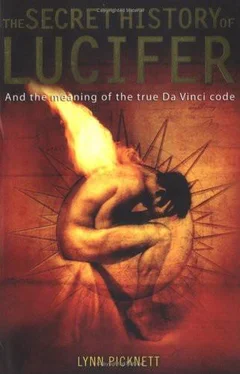Another, non-biblical, myth has God calling his angels together to admire his latest creation - Adam. The archangel Michael obediently enthused, but Lucifer was horrified, demanding to know `Why do you press me? I will not worship one who is younger than I am, and inferior. I am older than he is; he ought to worship me! [My emphasis]."'
Us and them
As Elaine Pagels points out in her excellent Origin of Satan (1995), all the stories of the Fall, both biblical and non-biblical, `agree on one thing: that this greatest and most dangerous enemy did not originate ... as an outsider, an alien, or a stranger. Satan is not the distant enemy but the intimate enemy - one's trusted colleague, close associate, brother.'48 Just like Judas, who was to bring about Jesus' torture and death according to a heavenly script, Satan brings about mankind's freedom of choice, although - as we have seen - he may have done so from almost altruistic motives.
Pagels notes that
Whichever version of his origin one chooses, and there are many, all depict Satan as an intimate enemy ... Those who asked, `How could God's own angel become his enemy?' were thus asking, in effect, `How could one of us become one of them?'49
But while an eagerness to divide the world into rigid categories of `Us' and `Them' is nothing new - the Greeks called foreigners `barbarians' and, tellingly, the Egyptians' word for themselves was simply `human' - the western Christian tradition degraded its enemies as primarily nonhuman: if they challenged Christianity they were God's enemies.
(Yet of course God himself had behaved reprehensibly in the story of the Fall. As Jean Markale writes:
... the Eternal God is bad-natured and horrendously jealous, and ... he behaves like a rich capitalist who has no intention of sharing his eternity with anyone else. For what pleasure would there be in it if everybody had it?)"
While sadly it seems to be a human failing to dismiss those outside the tribe or church as unworthy of the same rights and considerations, the Christians made this a moral and religious issue, which gave their later persecutions a fanatical edge as they used this attitude `to justify hatred, even mass slaughter'.51 As we shall see, this justification was used to extremes by the Inquisitors, largely against `heretics' - free thinkers, Christian dissenters, or women - but `revulsion at this doctrine is one of the main reasons for the decline of belief in the Devil since the eighteenth century' 52 However, while the Jews have tended to dismiss the importance of the Fall as simply an allegory of evil, for many Christians the story of Lucifer remains potent.
Lucifer is also depicted as the immortal serpent Sata, ruler of lightning, who takes on the Hebrew name Satan in Jesus' words: `I beheld Satan as lightning fall from heaven'.53 However, `Satan' as a synonym for `Lucifer' became `official' among Christians in the late first and second centuries, with the theological writings of Church Fathers Origen (born 185 CE) and Saint Augustine (354-430) - indeed, some theologians argue that Origen was the first to make this connection 54
To the famous Greek philosopher Plato, the god associated with the Morning Star was Aster (which means simply `Star'); Plato realized that it had a strange, dual personality, for it also appeared in a different celestial position in the evening. Plato lauded Aster as the ultimate dying-and-ri sing god, exclaiming: `Aster, once, as Morning Star, light on the living you shed. Now, dying, as Evening Star, you shine among the dead.'S'
Adversary and obstructor
A major tendency of JudaeoChristian thought is that God's opposite is a Satan, an `obstructor' of his will - which becomes, in New Testament Greek, diabolos, the Devil. But while the New Testament and the early Christians became increasingly concerned with building up Satan's role as they themselves fell prey to the barbarians and executioners, the Jews were, in the words of the American scholar Jeffrey Burton Russell `moving decisively in the other direction'. He explains: `[To the Jews] evil results from the imperfect state of the created world or from human misuse of free will, not from the machinations of a cosmic enemy of the Lord'."
In the older Jewish traditions Satan is known as Sammael, a
high angel who falls, uses the serpent to tempt Adam and Eve, and acts as tempter, accuser, destroyer and angel of death ... Satan has no existence independent of the Lord, who uses him as tester of hearts, an agent who reports our sins to the Lord, and an official in charge of punishing them 57
Satan continued to lose his personal glamour where the Jews are concerned: by the 1940s he had dwindled to `little more than an allegory of the evil inclination among humans'.51 This sophisticated interpretation remains fairly constant today, certainly among Liberal Jewish congregations. Christianity was, and often still is, rather different in this respect.
In the New Testament, Satan is Antikeimenos, the Adversary or enemy, the `archon of this age' - arction ton aiomon touton - or `ruler' of the early Christian era, according to the Church Father Saint Ignatius, Bishop of Antioch. Since the Fall, the Devil had held sway over humanity, but now the incarnation of Jesus, God's son, has shaken his influence, which will finally be exploded by the `Parousia', or Second Coming of Christ. In the meantime, however, the individual can ensure a place in Heaven via the doctrine of Atonement, a phrase first used by William Tyndale in the first English translation of the New Testament, in 1526. In fact, he had to invent the word - meaning `at-one-ment' - to convey the nowfamiliar idea of reconciliation, itself a term that did not exist in his day 59 This is also found in the later King James' or `Authorized' version of 1611, in New Testament passages such as `We also [have] joy in God through our Lord Jesus Christ, by whom we have now received the atonement' 60
However, Jesus became the man-god substitute for a much older idea of the Jewish scapegoat, when the chosen animal was ritually heaped with the sins of the people and sent off into the wilderness to die. But as Barbara Walker explains, `The Jews' Yom Kippur, Day of Atonement, was based on the Sumero-Babylonian kupparu, an atonement ceremony in which a sheep was ceremonially loaded with all the community's sins, and killed.'61 Jesus was symbolized as the sacrificial Lamb of God - although certain heretics, as we shall see, had a startlingly different version of this concept.
The New Testament declares `Thanks be to God, who gives us the victory through our Lord Jesus Christ:'62 that is, victory over `sin, death, and Satan' 63 This triumph was accomplished by Christ's willing death upon the cross, and the spilling of his holy, redemptive blood. As it says on posters outside countless churches: `Christ died for your sins.' Jesus atoned for the sin of Adam and Eve by his sacrifice, and in dying became our saviour. After the doors of Paradise were slammed shut, his blood was the price that re-opened them. However, to non-theologians this presents a complex and rather contradictory conundrum, for if Christ has already died for our sins, why do we need to be baptized, live a good life, and die in a state of grace to hope to reach Heaven? This scenario had not bypassed the Church Fathers: as Barbara Walker notes:
Among medieval theologians there was a general opinion that Jesus' sacrifice was not really effective; only `a few' were saved by the Savior's death. St Thomas Aquinas and others claimed the vast majority of people were still doomed to eternal suffering in hell' Thus the theory of atonement for all time or for all humanity was actually denied by the same church that pronounced it as a basis for worldly power 65
Take the concept of Atonement out of the picture, however, and it makes more sense, for baptism is an outward and visible sign of the individual's cleansing of sin and commitment to lead a good Christian life and deny the Devil. In fact, the early Christians were exorcized before being baptized - no doubt a considerably tougher and perhaps even more traumatic ritual than today's polite dips and modestly clad dunkings. This was hardly surprising, as the precursor of the Christian rite also took that form, the Egyptian baptisms in grand temples dedicated to Isis and Osiris on the banks of the Nile were preceded by public confessions of sins, and dramatic exorcisms 66
Читать дальше












